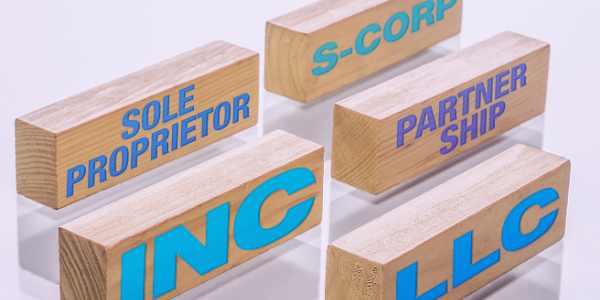Starting a business is all about making decisions.
And one of the most important is the type of legal business structure you select for your company. This decision impacts how much you pay in taxes, the amount of required paperwork, the personal liability you face, the ability to raise capital and if the business can continue without you.
Common business structures include a C Corp, S Corp, LLC (corporations), GP, LLP, LP (partnerships) and sole proprietorship (sole props). Additional corporate categorizations for professionally licensed business owners include PLLC and PC.
Generally speaking, incorporating will be more complex than opening a sole proprietorship. It involves greater fees and expert guidance to ensure protection of personal assets and the most favorable tax situation. Partnerships and sole props require little paperwork and assistance to form, but they are not protected by the same liability and tax guidelines.
How do you decide which is right for your business? Should you incorporate, form a partnership, or go it alone? Start by reviewing your options below and then consult tax and legal advisors.
Selecting A Business Structure
Here is a summary of common business structure types and what each can offer.
.jpg?width=945&name=Business%20Struture%20Chart%20Graphic%20(3).jpg)
The primary differences among all types of business structures are how taxes are collected and where liability lies. Keep in mind that laws and regulations differ from state to state.
C Corp – Regular Corporation is a separate legal entity from those forming it. Directors and officers carry the responsibility for the company’s operation. The company is liable for its own debts, but an individual’s liability is limited in case of lawsuits. The company pays taxes on its earnings while owners/shareholders pay taxes on distributions. The company can sell stock to raise money and must hold annual meetings and submit meeting minutes. The corporation continues if an owner leaves or stock is sold.
S Corp – Small Business Corporation carries the same liability and business continuation as a C Corp, but the organization is limited to no more than 100 shareholders who must be U.S. Citizens. In addition, profits (or losses) are reported on the owner/shareholder’s personal tax return. An S Corp can also issue stock to increase cash flow and must hold annual meetings.
LLC – Limited Liability Company is offered by each state and has no restrictions on member numbers. Members can even be other companies. Similar to an S Corp, the individual members are not liable for company debts and tax responsibility is passed on to the owners. However, required malpractice liability protection is not offered with this type of structure. Another difference is that if any member leaves, the LLC is dissolved.
PC – Professional corporation is formed by state-licensed professionals(s) such as doctors, lawyers, accountants or engineers in the same industry. Certain states require this structure instead of an LLC or PLLC because it offers malpractice lawsuit liability protection. It will be taxed like C Corps on company earnings and owners also pay taxes on distributions. Ownership can be transferred to another qualifying professional.
PLLC – Professional Limited Liability Corporation has similar ownership regulations to a PC. A single professional member can opt to pay taxes like a sole prop; multiple members are all taxed as a partnership. Required malpractice liability protection is not offered and this structure is not available in all states. Ownership may transfer or the company may dissolve.
GP – General Partnership includes two or more partners. Each partner claims income or losses on personal income tax returns and can be liable for company debts, lawsuits or agreements made by all other partners. Partnership agreements, or buy-sell agreement, are essential for understanding roles and planning for a partner’s decision to leave.
LLP – Limited Liability Partnership assumes all partners are actively involved in the management of the business. Partners are not liable for negligence claims again themselves or other partners. This allows professionals to protect their own assets from malpractice suits. Each partner is personally responsible for taxes and will claim income or losses on personal income tax return. If a partner leaves, the business remains intact unless all partners agree to dissolve.
LP – Limited Partnership consists of a general partner involved in the active management of the business with limited partners – silent partners or investors – who are not actively involved and have no voice in operations. The general partner may be personally liable for company debts, while silent partners have limited liability. Similar to the LLP, each partner claims income/losses on their personal return and can decide to leave the partnership depending on partnership agreement.
Sole Proprietorship has one owner who is personally liable for all company debts and decisions. He or she reports income and losses on a personal tax return. If the owner sells, the new owner must re-file any relevant licenses or permits.
Weigh The Options
You have to pick the business structure that is right for you. It will guide decisions on everything from day-to-day operations, to the level of risk to your personal assets, to how taxes are paid. Choose a business structure that gives your business the right balance of legal protections and benefits.
No one knows the circumstances of your individual business better than you. By reviewing the options carefully, you will be able to make an informed decision and put your energy into running a successful business.
Remember – be sure to consult with tax and legal professionals before making legal or financial decisions that may impact your business.
If you’re interested in a small business loan with Stearns Bank, just click below.

